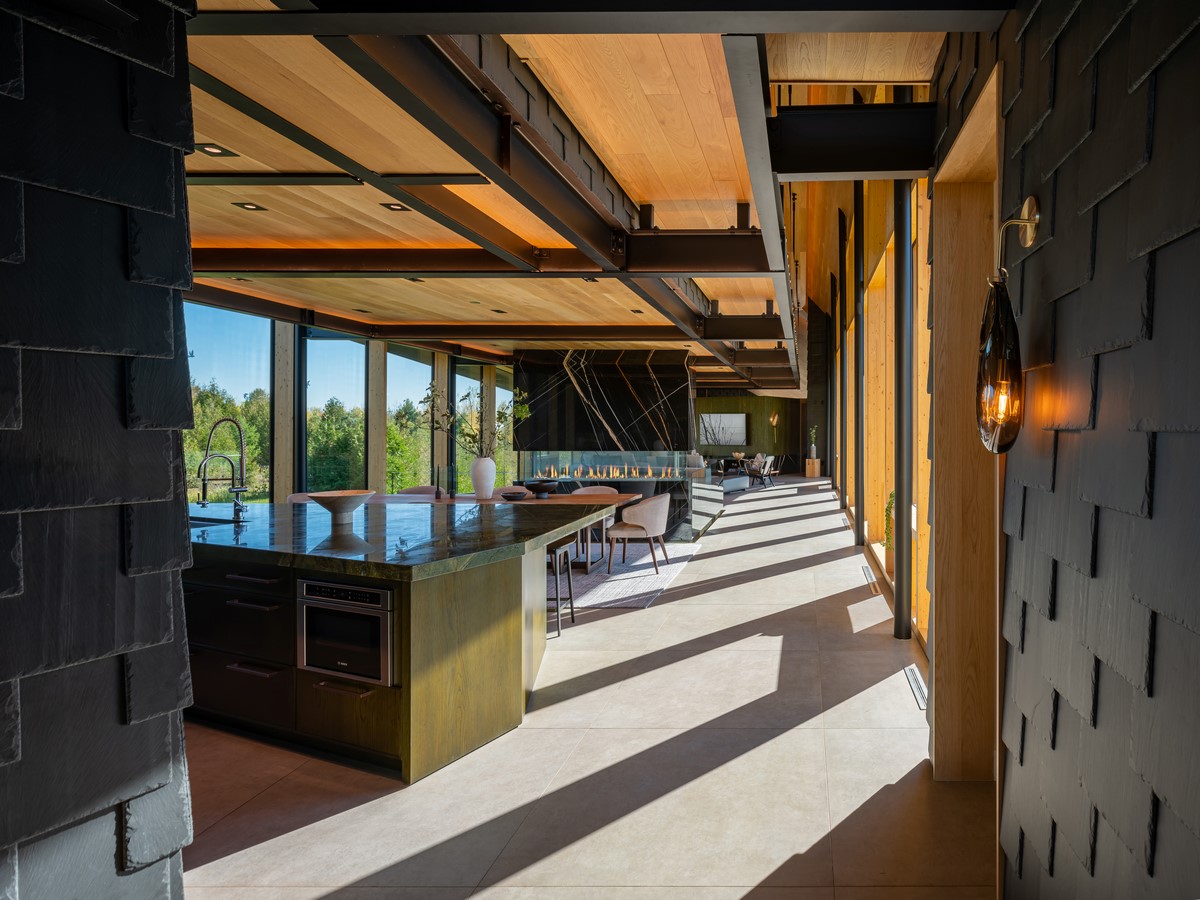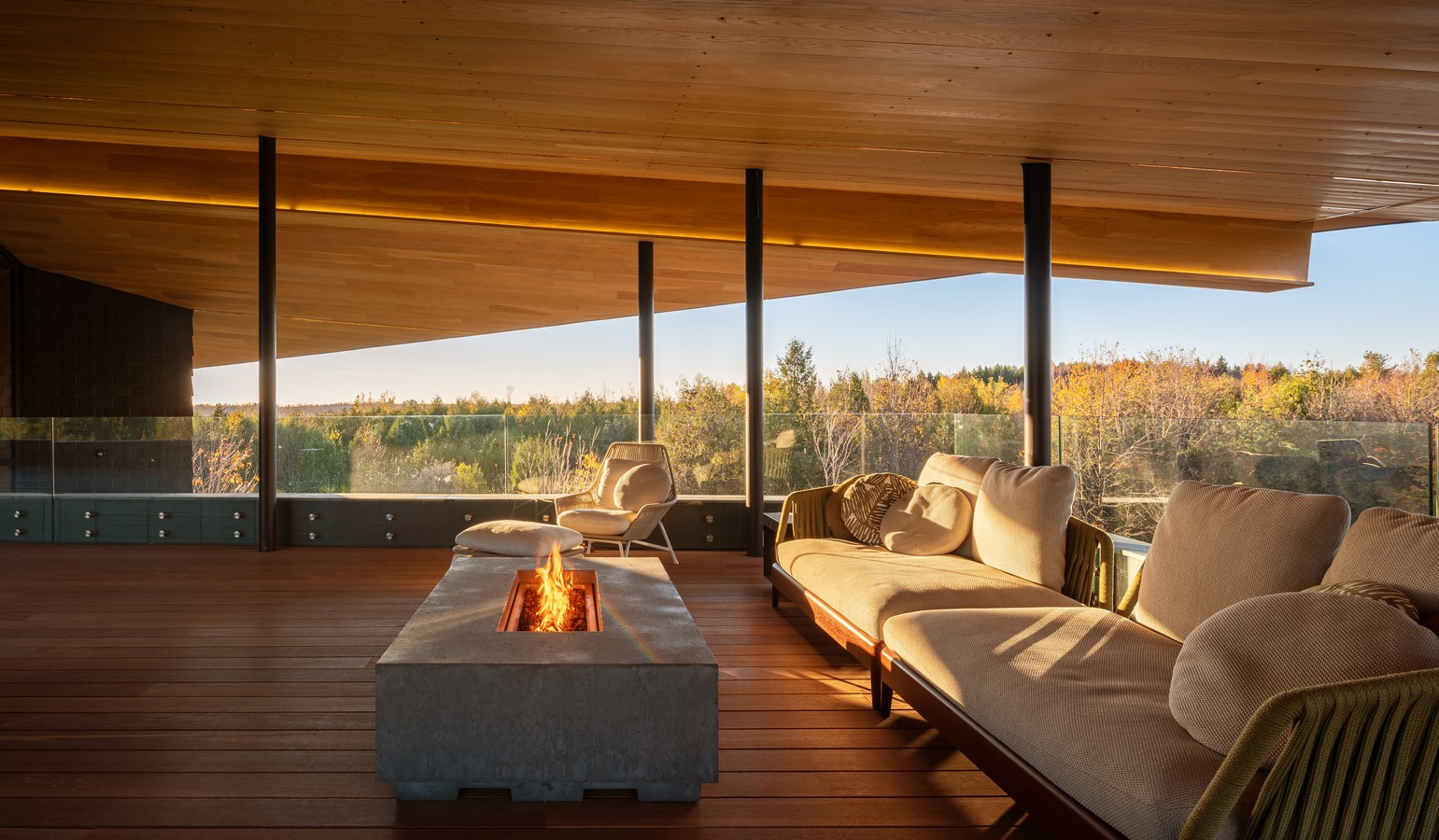A Family Retreat in Rural Ontario
The clients for this project requested a “rustic, modern retreat” for their 100-acre property of forest, wetland, and meadows. They sought a generous home that would allow young teenagers and extended family to be comfortable in a remote area for long stays. The home needed to be a casual, comfortable space for the family and their dogs that would encourage activities like hiking and snowshoeing — no fancy entertaining.
Office Name: Kariouk Architects
Office Website: https://kariouk.com/
Firm Location: Ottawa, Ontario, Canada
PROJECT INFORMATION
Project Name: Forest Retreat
Completion Year: 2021
Gross Built Area (m2/ ft2): 10,300 ft2
Project Location: Caledon, Ontario, Canada
Program: Residential
CREDITS
Design Team:
Paul Kariouk (Principal)
Chris Davis (Project Architect)
Adam Paquette (Intern Architect)
Joel Tremblay (Design Associate)
Mark Meneguzzi (Design Associate)
General Contractor: Michael J Dunn Construction
Structural Engineer: Blackwell Structural Engineers
Interior Decorator: House of Bohn
Photographer: Scott Norsworthy

The home needed to encourage this large, young family to become closer and to connect with the simple joys that can be found in nature. They live abroad but wanted a Canadian homestead — an anchor. During summer and winter holidays, the parents wanted their children immersed in an Ontario landscape like the one in which they were raised.
Under One Roof
The roof became an artistically important part of the design in order to create an open interior that would encourage family closeness, and to harmonize the structure with the landscape by having the roof follow the topography of the site. The roof and its ridge beam became the design’s primary focus, shaping the circulation path through the home’s interior, ultimately extending a view toward the forest. A primary technical challenge then became the roof’s structure, which despite its 60-metre length needed to seem light. The roof is supported by a steel ridge beam that changes angle at two points. Again, steel was used for the roof because of its strength.
At the entry side of the house, the roof lifts like a bird’s wing off the garage volume beneath, sheltering an outdoor terrace. The folds and angles of the steel roof are supported by the meandering ridge beam.

Playing with Heavy and Light
Contrasting against the light appearance of the roof, monolithic slate-clad volumes anchor the home and define the space between the curtains of glass. These opaque volumes echo the property’s rock outcrops. The garage, bathrooms, stairs, and pantry are grouped inside, and appear to hold up the dynamic roof.
Steel construction was chosen to avoid using the expected material of heavy timber for this forest getaway. Being mindful of the clients’ desire for an appearance of warmth in the interior, it was also important to avoid modernist tendencies for box-like forms.
Because the main floor is lifted above the ground and the topography falls away, the main floor is in the treetops while simultaneously filling the lower recreation area with light. Through glass walls and other observation points, residents enjoy a view of the unspoiled landscape, allowing them to maintain a connection with nature, even when indoors.

A Contemporary Approach to Warmth and Closeness
The continuous open space of the home, with only bedrooms and bathrooms closed off, is a layout that encourages closeness.
The family areas and parents’ bedroom and ensuite bathroom are on the main level; The kids’ bedrooms are bundled into a single slate-clad volume, suspended like a cocoon above the main floor from a 40’ steel beam and accessed by a catwalk.
Sustainability
To avoid cutting trees, the home was placed on an existing cleared ridge overlooking a wildflower meadow. One of the fundamental aspects of sustainability is habitat preservation. If a project preserves most of a landscape, space is created for trees to sequester carbon through photosynthesis and growth, watersheds remain healthy, and wildlife can thrive. A key contribution of the project to the area is that it preserves most of the landscape that it occupies. While it is a sizable structure at 10,300 sq feet, it was sited on an existing rocky area overlooking a wildflower meadow to avoid cutting trees. Almost all of the natural habitat of the 100-acre property was preserved, including its wetlands.
The home is heated and cooled via a geothermal heat pump with summer solar gain reduced by significant roof overhangs. The roof is highly insulated to help keep the home warm in winter and cool in summer. The glass walls are triple-pane, and high-efficiency fixtures and equipment for the well and septic system help reduce the home’s environmental impact.

Historically, the Canadian identity has been defined by our relationship to the land. Fulfilling the client’s mandate, the home honours that emotional connection through visual and material harmonization with its surroundings.
This project includes almost no traditional landscaping. Considering that natural spaces are shrinking worldwide, and with them our ability to have simple yet profound experiences of connecting with nature, the home preserves a small treasure for the future.
Materials and Finishes
The use of wood, slate, and glass as materials and finishes (internally and externally) helps fulfil the ask for a “rustic, modern retreat”.
One of the artistic motifs for the project was balancing visually heavy and light aspects of the home. Monolithic, opaque slate-clad volumes anchor the home and define the space between the curtains of glass, appearing to hold up the dynamic roof. Slate was chosen to echo the property’s rocky outcrops, and this material is also used on the interior to harmonize it with the exterior.
Being cognizant of the clients’ desire for a warm interior, in spite of the use of steel and slate, we used wood — but in some atypical ways.
Sustainably-harvested Canadian white oak was used throughout the project, and its use on the underside/interior surface of the entire roof helps create the warm feeling that the clients wanted. This same wood was also used for the window framing, when normally aluminum or steel would have been used. White oak is also used for the doors, doorframes, and stairs, as well as exterior trim along the home’s first floor.
The interior involves visible steel framing to support the topmost floor with its row of bedrooms connected by a catwalk.





















